Droning on
This week: Lingua franca; Fundamentals; If a job’s worth doing; Let building commence; Camera configuration; Droning on; Climate update;
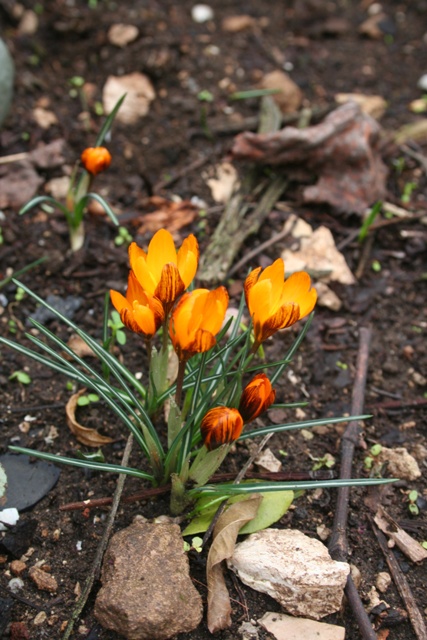
It’s February (just) so one month down in 2020 already. The nights are really noticeably drawing out and here in the far south east corner of Europe, it is getting warmer too.
Sadly I am now officially no longer a European. As the UK left the EU at Midnight CET last night, British citizens in Europe are now classed as TCN’s – Third Country Nationals.
I personally feel downhearted because having lived in several EU countries, I regard myself as a European. Future historians will give a verdict on what many consider to be a monumental act of national self harm.
Although coming from the UK, I now have few ties to the country. However my European-ness has been removed without me being able to have any say or input. I have never really felt British, English yes, a Yorkshireman definitely – and that’s almost a nationality – but what does British mean?
I do despair at the triumphant jingoism emanating from the political ruling class and think many of those who voted to leave the EU will come to regret their decision.
According to the Croatian Ministry of Interior, there are just over 460 UK residents in Croatia who have permanent or temporary residency status. I’m one of the permanent ones but I do wonder how it will affect us in the future.
There are many more who own holiday homes here, or simply visit to enjoy the warm seas, superb food and convivial atmosphere.
Lingua franca
I hated Latin when I was at school. Learning was by rote, and I suppose that in that respect it worked because I can still remember the conjugation of some verbs, for example:
To Be: Sum, es, est, sumus, estis, quod sumus, estis, and for some bizarre reason, the verb To Love: Amo, amas, amat, amamus, amatis, amant.
It did help me in my career because the legal profession and the courts use Latin, as do the Medical profession, both of whom I regularly came into contact with.
But in trying to learn Croatian, it is not much use. The reason is that modern Croatian is a Slavic based language, rather than Latin based.
This means that the Croatian verb To Be is: Ja sam, ti si, on je, mi smo, oni jesu, ti si
But here on the island local dialects still rule – versions of the Chakavian, but personalised – so people from Dol speak Dolski. The Dol dialect isn’t understood in Grad Hvar, let alone in Split. Equally, the Split dialect cannot be understood be people here on the island.
English is the Lingua Franca for foreigners on the island, but that is only of recent origin. In the days of the Yugoslav republic it was German that was taught in schools.
Fundamentals
All the time I come across language anomalies. I was checking some English for a publication this week and came across the word “Vir”.
It seemed to be either Latin or Greek, but in Latin Vir means ‘man’ and in Greek, ‘here’. Both Greek and Latin words were used in the document, but I guessed it meant a “spring”. In Croatian that is izvor, in Greek ‘peeje’ and Latin ‘fons’. Vir is a dialect word for a spring.
Following the OHIO principle (only handle it once) I have a couple of really big potted plants that need to be moved out of the way of the builders.
They will eventually go into the ground, somewhere near the drystone wall that divides the old fold yard from the top orchard. But at the moment, I don’t have the place, or space to dig them in.
So I decided I would move the plant pots and put them adjacent to the wall. However I needed somewhere flat for them to go.
So I started this week to dig in the stones that I am using to extend the landing area at the head of the flight of stone steps down into the orchard. The basis of every good construction, is a good foundation. I know from my friend Cvjetko that here they are called “fundamenti”.
Of course in English, we have “fundamentals”, which has the meaning according to the OED of “being central to, forming the necessary basis of something”. It comes from the Latin, “Fundamenti” meaning Foundations. Who says Latin is a dead language….?
If a job’s worth doing…
It’s worth doing well. That is how I have always been taught and I try and apply it to everything I do. Laying large stones is no exception.
I am only going to do this once and it needs to last, preferably for the next 50 years (minimum) then it will become someone else’s responsibility…
So with that in mind I started to dig out the soil where the landing stones will go. This was where there was once a lean-to animal shelter, so the soil is a rich, black earth.
With my impoverished soils, that is something I will not waste, so I carefully dug out the blackness, even finding worms – very much a rarity in my poor soils. The soil was riddled to remove any small stones, but keeping the worms. I moved it to where flowers and shrubs will be planted later in the year.
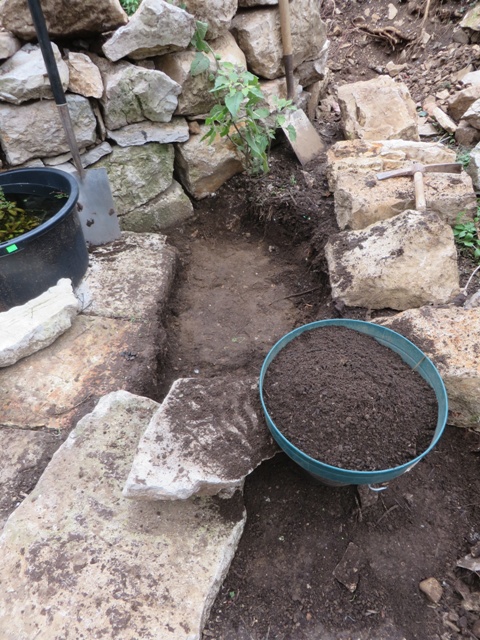
There was a clear line, about 25cm down where the black soil changed to pale sandstone.
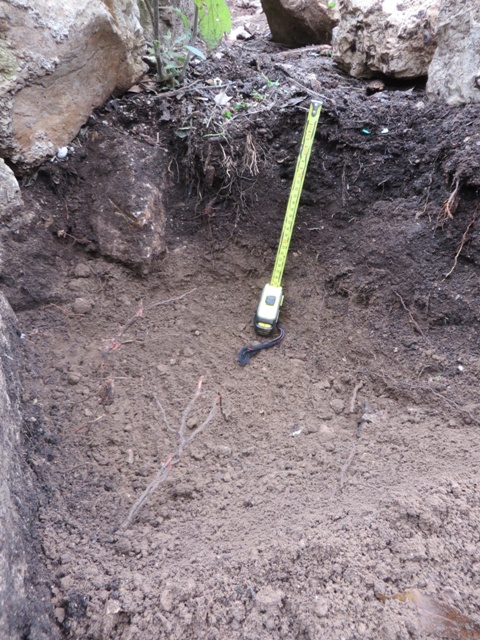
The sandstone was quite soft and was not difficult to remove. Measuring the flat stones, they were all in the region of 20 cm deep. I excavated around 12 cm of this sandy layer and put it to one side. It will be used later as a fill.
I put a 5 cm layer of stones in the bottom, followed by three or four centimetres of small pebbles. Each layer was tamped into place so there was a solid base to put the landing stones on.
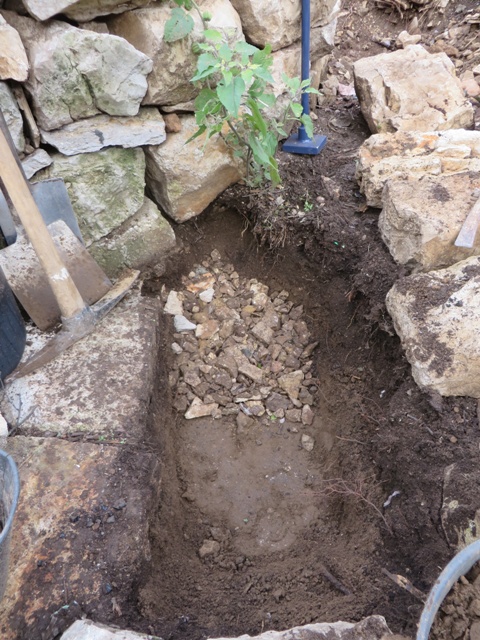
Finally I laid a couple of centimetres of pure soft sand on top, then bedded the stones individually into place.

I am recovering the soft sand by riddling it from the spoil heap. This was created when I excavated part of the courtyard. It was a little damp, so it didn’t flow through the sieve as easily as it does in the summer when everything is dry, but it was still not exactly hard work.
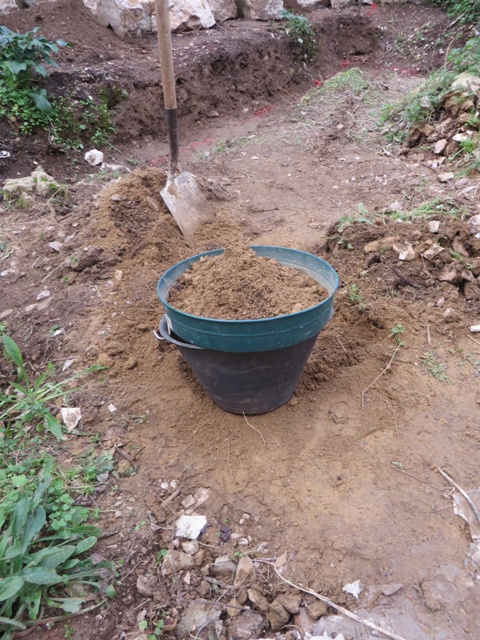
With warm spring sunshine it was very pleasant working in this area of the garden. I had a Robin coming to take grubs from the piles of spoil I was creating, and Great Tits were calling from the plum trees above my head.
The first stone went in very well, however it still took a full working day to lay just one third of the width of the landing area.

All the stones have been well packed and wedged together to prevent any movement. To finish the job properly, I have brushed the sharp sand into the gaps. These gaps I will plant this spring, with herbs – anything to keep the weeds at bay!
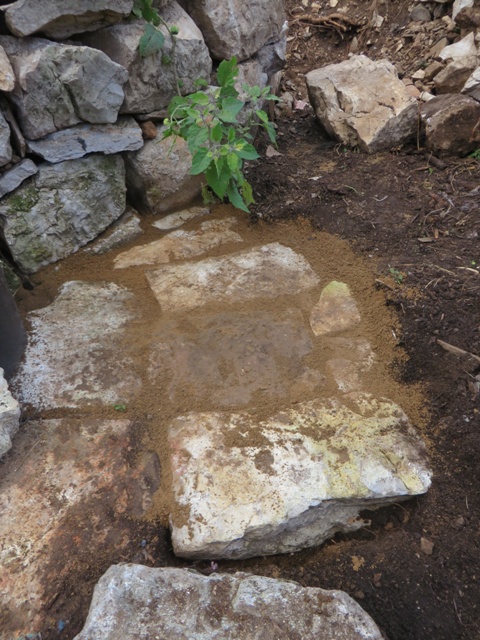
Let building commence
My builder called on Wednesday morning to announce he would start work on Thursday. Ismail and his crew arrived spot on 7am on Thursday morning.
It took several runs to the municipal tip with the spoil that has built up on the area where the new workshop will go, then the team started to dig and refine the foundation footings.
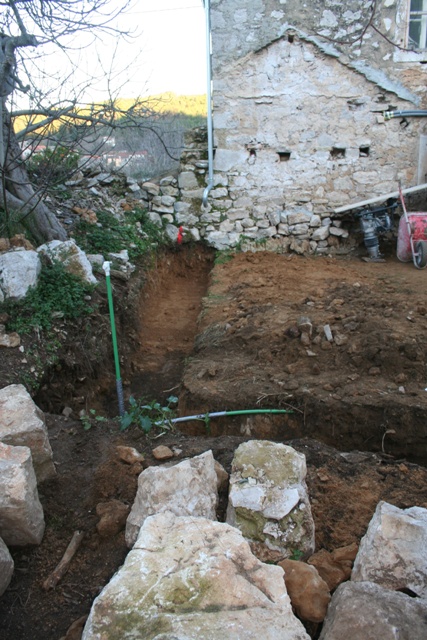
The architect has specified 50 x 50 centimetre foundations reinforced with a steel ring beam. While the excavations were taking place, Ismail was constructing the steel ring beam from four metre lengths of rolled steel rebar.
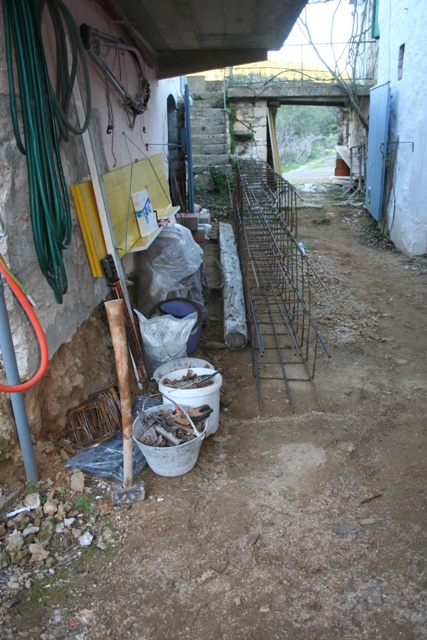
The bottom of the trenches were compacted by a vibrating trench rammer.

With the trenches complete, they left at 16:30 and returned at 7am again on Friday.

On Friday the builders spent the day putting in place the form work for the concrete.
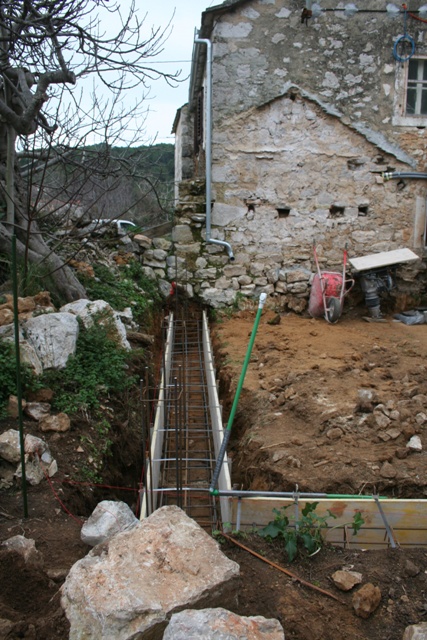
It instantly became an adventure playground for cats.
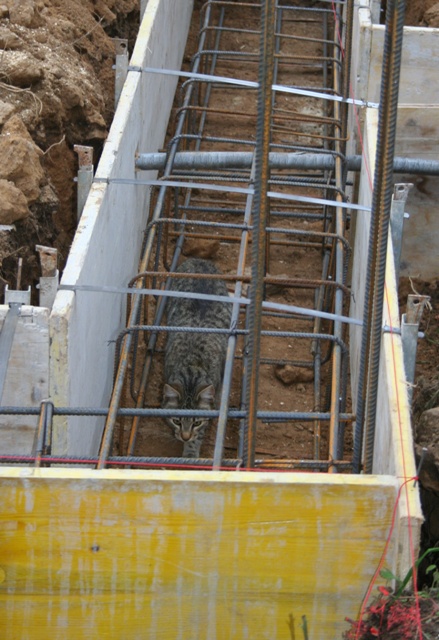
Then on Saturday they started mixing and pouring the concrete. There was a huge pile of aggregate, dozens of bags of cement and lots of men working very hard.
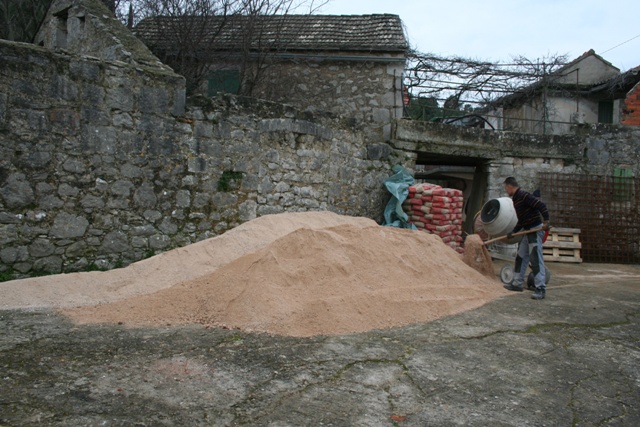
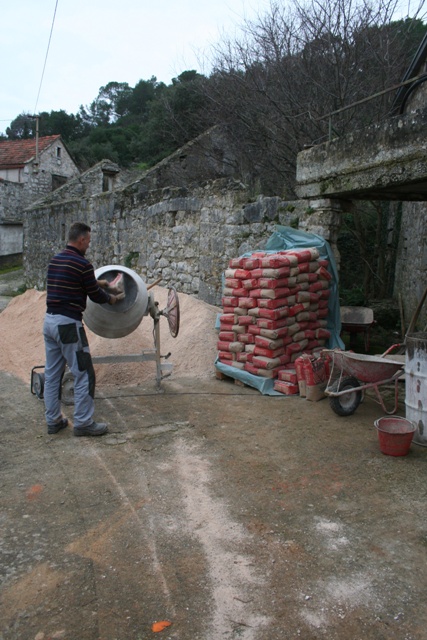
After three days there has been significant progress! I’m on the way to having my buildings joined up!
Camera configuration
Apart from recording where the utilities are are, I want to record progress. I also want to try and make a short time-lapse video so you can see zero to completion in two and a half minutes.
I have all the technology, an Enlaps Tickee solar powered time lapse camera and the software, but this will be the first time I have used it in this way.

It took a couple of hours on Wednesday evening to configure the camera and charge the batteries. I’ve no idea what the result will be, time will tell…
With the camera installed on the wood shed, it should provide some interesting shots.
Droning on
I have of course taken some regular photographs this week too. I thought I would experiment with trying to include a slider in the blog.
Sliders are a common on-line way for you to see before and after photographs. Moving the arrow in the centre to expand one or other of the images.
The UN uses this technique to show changes in places like the Amazon, however I see no reason not to try something on a much smaller scale.




To look good, it requires photographs taken from exactly the same viewpoint. With a hand held camera, that isn’t easy. I’ll let you be the judge of how successful the experiment has been.
Not having flown the drone in six months, I also charged its batteries and upgraded the firmware.
I completed a short flight over the building site to give you the aerial point of view.
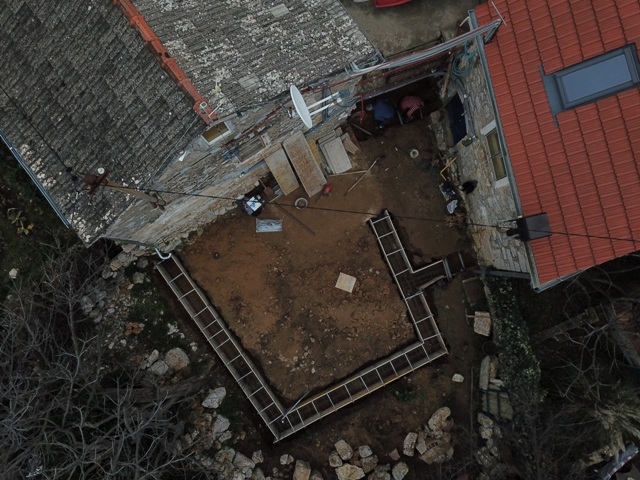
The footprint of the building will add close to 40 square metres of usable space.
Climate update
We had a little rain this week, the first rainfall in January. This takes us well over 50 litres per metre² above the average for winter. This is because of the very wet November we had last year, then almost five weeks with nothing.

Given that the island is on porous Limestone, rainfall will quickly percolate down through the underlying rock strata. This means that thin island soils quickly dry out.
At the moment my soils are damp, but as spring advances and everything starts to grow, the water take-up will quickly deplete the subsoil.
There is no sign of any significant rain over the next couple of weeks. With only eight weeks to go to the end of the “winter wet” season, it looks as though a lot of irrigating will be called for later in the year.
The daily temperatures are already 3.5 degrees above the five year average.
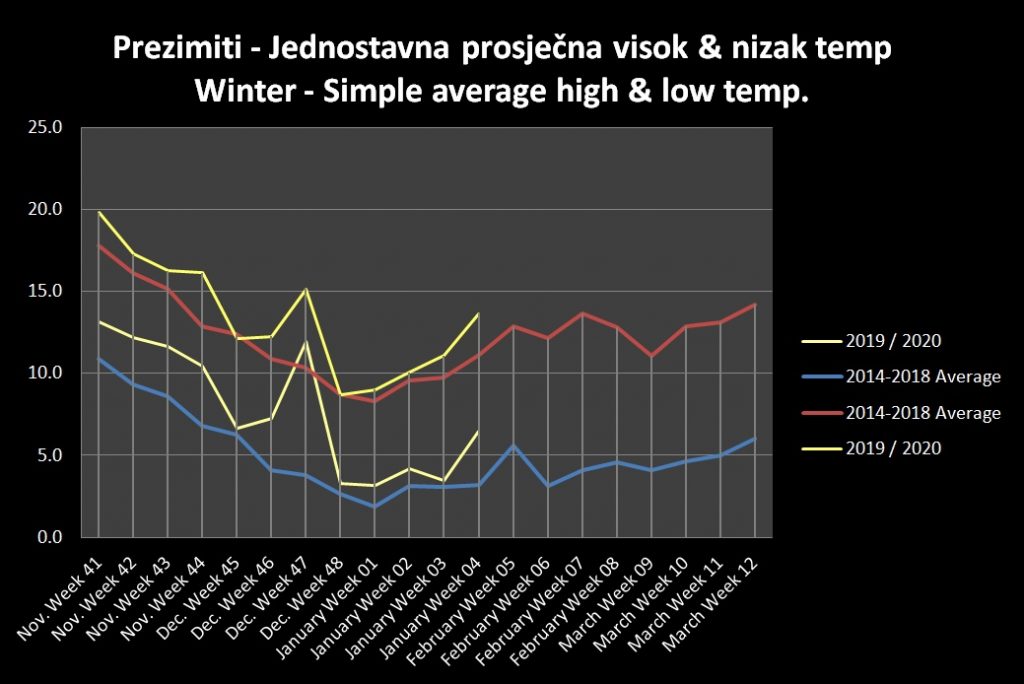
My Sprinwatch callendar suggests the we are more than a week ahead of last year. NRC
4 Responses
Rick
“Sliders” looked great. I would like to see some drone footage of the area you live in.
Steve
Glad the building work has started. You certainly deserve a medal for jumping through so many hoops
Michael
I concur on the need for more overhead footage, and even an outline map of the green and house to allow your followers to place things relative to each other.
Looking at your foundations I can only assume that their strength is to do with earthquake proofing – it’s going to be a fortress!
Andy Obridge
I live on the mainland just across from Norman, Michael, even two small extention outbuildings I have are built to resist a 6.7 earthquake! That I believe is the normal standard for new Croatian buildings.